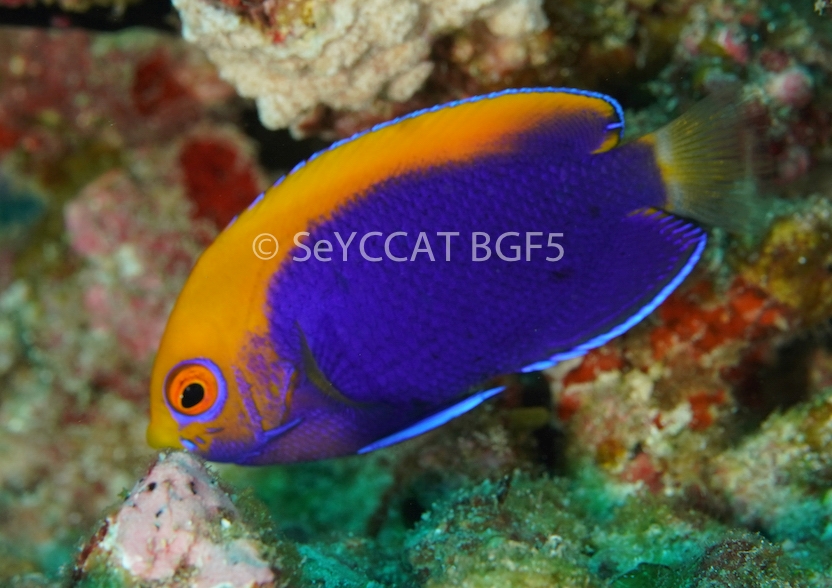Description:
Dorsal spines: 14; Dorsal rays: 16-17; Anal spines: 3; Anal rays: 16-18.
Small angelfish. Lower rear edge of preorbital with 1-4 large spines.
Colour a dark blue to blackish angelfish with orange-yellow head, upper sides, dorsal and caudal fins. Close set purple spots on anal fin. Electric blue edge to dorsal,
anal and pectoral fins.
Size:
Maturity: Unknown. Max length : 8.0 cm TL.
Habitat and Ecology:
Inhabits areas of coral rubble withh thick algal growth (depth 6-40 m). Feeds on small invertebrates and algae. Typically occurs in small groups of up to 10 individuals.
Bi-directional sex change has been confirmed for this species. Eggs pelagic.
Fishery Status:
This species is not protected or subject to fishery regulations. It is too small to be caught in the artisanal fishery.
Notes:
Photo courtesy Eleanor Brighton and Chris Mason-Parker (c) 2022 Blue Safari Seychelles/Marine Conservation Society, Seychelles. Photograph taken at Alphonse group 2022.
References:
Bray, D.J. Centropyge acanthops in Fishes of Australia, https://fishesofaustralia.net.au/home/species/5163 (13/07/22).
Fricke, R. (2010). Centropyge acanthops. The IUCN Red List 2010: https://dx.doi.org/10.2305/IUCN.UK.2010-4.RLTS.T155083A4694588.en. (13/07/22).
Froese, R. & D. Pauly. (Eds.) (2022). FishBase. https://www.fishbase.de/summary/9222 (13/07/22).
Smith, M. & Heemstra, P. (Eds.) (1999). Smiths’ Sea Fishes Edition 6. Springer-Verlag Berlin Heidelberg 10.1007/978-3-642-82858-4
Citation:
Nevill, J.E.G., Brighton, E. & Mason-Parker, C. (2022). Centropyge acanthops, Orangeback angelfish. Seychelles Seatizens. www.seatizens.sc. https://seatizens.sc/species/centropyge-acanthops-norman-1922/


This design is incredible! You obviously know
how to keep a reader amused. Between your wit and your videos, I was almost moved to start my own blog (well, almost…HaHa!) Wonderful
job. I really enjoyed what you had to say, and more than that, how you presented it.
Too cool!
هی برای کاربران اینکه جستجو پول راحت
هستند. وبسایتهای بازی شرطی تله
گستردهای میباشند زیرا عامل اعتیاد همچنین خسارت عمیق مینمایند.
من هزاران پول از دست دادم و اکنون متأسف هستم.
خواهش میکنم دور شوید و به
امور مثبت روی شوید!